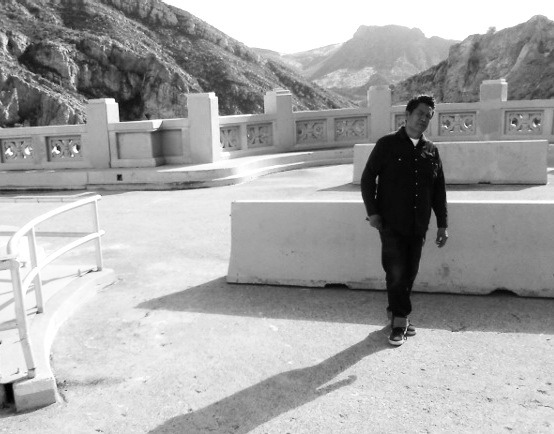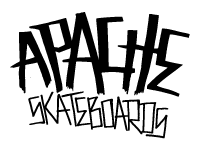=What Tribe Is This =
Eriberto Oriol X Apache Skateboards
Chicano photographer Eriberto Oriol is prolific. The heavy tone of his L.A. photographs were gripping portraits I had admired for years. We met at Self Help Graphics in East L.A. during their annual Print Sale and discussed a future collaboration. I was honored as he photographed my family that day. Eriberto wanted to support the work of my company Apache Skateboards (AS) as we travel, skate and work in various Native American communities. He asked me to select a photograph of his to work on. He later gifted AS, two large limited edition works screen printed at Richard Duardo’s “Modern Multiples” in L.A. I began to imagine inscribing my Apache “rez life” graphics upon his gritty photo homage to the City of Angels.
Eriberto hails from San Diego’s Barrio Logan. His exodus to L.A. sparked a new chapter in his activist work. In L.A. he met his art-crime partner and wife, Angelica Gonzales-Oriol. They ran an art gallery, Pico House supporting new talent. They held and curated the first major show of L.A. graffiti art, “Burning Desire”. This L.A. Graf retrospective took place in 1990, a mere 20 years before “Art In The Streets” at L.A.’s MOCA.
Eriberto’s work is seen in many publications often alongside his son Estevan Oriol. It was Eriberto that gave his son a camera to photograph his road work with seminal hip-hop group, Cypress Hill. A fathers gift to a son kicked off a small visual revolution in how Chicano life is documented via photography. His son Estevan Oriol and friend Mr. Cartoon would later go on to champion a raw Chicano aesthetic in their media works not seen since the creation of Lowrider Magazine. In 2011, Carmichael Gallery held a retrospective exhibition, “Like Father, Like Son”. If Estevan’s work is a microcosmic look into Chicano street life and culture, Eriberto’s work is an even broader macrocosmic view into Los Angeles streets and its citizenry from the ground up.
Eriberto Oriol’s photography stands out as some of the most iconic deeper looks at L.A. street life. Shooting in the tradition of Gordon Parks he utilizes the camera as a weapon against poverty, class struggle, racism, genocide and American apathy. These issues we still face as a nation now evident in the Trayvon Martin case. His photos speaks volumes about racism in America. “Welcome To L.A.”, taken at the Los Angeles Democratic Convention is a telling take on police state politics as it becomes the norm in many urban communities of color. His LAPD in full intimidation riot gear mode photo serves as visual reminder, ” we’re not in Kansas anymore”.
As we discussed our collaboration I selected his “America’s Most Wanted” (AMW) to work with. Eriberto reported it was an everyday occurrence to see LAPD/Sheriffs “rounding up” the homeless. From a second floor hallway he records something from a bygone racist era, except it was taken in 1998. About that time the Rampart Scandal was beginning to break. The scandal revealed widespread corruption in the LAPD anti-gang unit in the late 1990s. We can see from the photo who the victims of racial profiling and brutality are. Its also reminiscent of a scene from Antoine Fuqua’s Academy Award winning
” Training Day” film starring Denzel Washington as a corrupt rogue cop. It’s arguable but likely, the artistic director/cinematographer referred to the work of Eriberto (and Estevan ) Oriol for a “distinct L.A. look” for their film.
Upon viewing AMW, I saw the homeless men as “Indians”. Police officers in “Cowboy” role sent to win the West once again to rid the frontier of its indigenous inhabitants. Creating a layered mix of ink drawings and stencils I gave careful place not to disrupt the characters in his photo. A ghostly Geronimo, warrior, son, men and a woman watch invisibly as if to protect. Apaches in the collaborative work observe genocidal racial profiling they experienced. It’s an update on the destructive manifest destiny philosophy. Eriberto captured history’s sad repetition. The new art collaboration is titled:
“Cowboys & Indians”
Only the best artists approach serious issues and art without their work de-evolving into a superficial trend. Weaving social commentary into art is the work of artists involved in community. Artists like Stevie Wonder, Bob Dylan, Marvin Gaye, Bruce Springsteen, Bob Marley, El Mac and Mear One come to mind. Our co-lab work was unveiled at “What Tribe ” ( art addressing stereotype) in Phoenix, Arizona in March 2013. “Tribal” artists came together to create awareness and understanding between communities. We often look to artists that keep the flames of social justice lit. This is how barrios, reservations, neighborhoods, and communities become stronger, via friendship and collaboration. Eriberto Oriol is one of these artists and I’m proud to join him. Viva La Revolucion.
Douglas Miles







